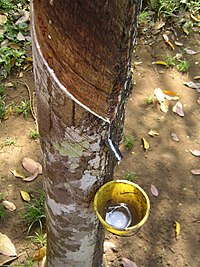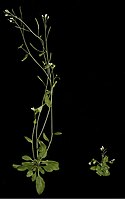
The soybean cinnamate 4-hydroxylase gene GmC4H1 contributes positively to plant defense via increasing lignin content
Sign Up to like & getrecommendations! Published in 2019 at "Plant Growth Regulation"
DOI: 10.1007/s10725-019-00494-2
Abstract: Lignification is a key event in plant defense against pathogens. In the plant lignin biosynthetic pathway, cinnamate 4-hydroxylase (C4H) catalyzes the conversion of trans-cinnamic acid to p-coumaric acid. However, the potential role of C4H in… read more here.
Keywords: soybean; plant; gmc4h1; plant defense ... See more keywords

Volatiles as inducers and suppressors of plant defense and immunity-origins, specificity, perception and signaling.
Sign Up to like & getrecommendations! Published in 2018 at "Current opinion in plant biology"
DOI: 10.1016/j.pbi.2018.03.008
Abstract: Volatiles from attacked plants, microbes and herbivores can enhance plant defenses. However, the absence of volatiles rather than their presence has sometimes been associated with enhanced defense, suggesting that volatiles may also act as defense… read more here.
Keywords: suppressors plant; plant; defense; volatiles inducers ... See more keywords

Involvement of OsRIP1, a ribosome-inactivating protein from rice, in plant defense against Nilaparvata lugens.
Sign Up to like & getrecommendations! Published in 2019 at "Phytochemistry"
DOI: 10.1016/j.phytochem.2019.112190
Abstract: Rice is the most important staple food in the world, but rice production is challenged by several biotic stress factors like viruses, bacteria, fungi and pest insects. One of the most notorious pest insects is… read more here.
Keywords: insects; rice; ribosome inactivating; nilaparvata lugens ... See more keywords

Laticifers, Latex, and Their Role in Plant Defense.
Sign Up to like & getrecommendations! Published in 2019 at "Trends in plant science"
DOI: 10.1016/j.tplants.2019.03.006
Abstract: Latex, a sap produced by cells called laticifers, occurs in plants of wide taxonomic diversity. Plants exude latex sap in response to physical damage. Questions about the function of latex or the underlying mechanisms persist,… read more here.
Keywords: defense; laticifers latex; latex sap; role ... See more keywords

Chickpea-Fusarium oxysporum interaction transcriptome reveals differential modulation of plant defense strategies
Sign Up to like & getrecommendations! Published in 2017 at "Scientific Reports"
DOI: 10.1038/s41598-017-07114-x
Abstract: Fusarium wilt is one of the major biotic stresses reducing chickpea productivity. The use of wilt-resistant cultivars is the most appropriate means to combat the disease and secure productivity. As a step towards understanding the… read more here.
Keywords: fusarium oxysporum; defense; oxysporum interaction; plant defense ... See more keywords

Benzothiadiazole, a plant defense inducer, negatively regulates sheath blight resistance in Brachypodium distachyon
Sign Up to like & getrecommendations! Published in 2018 at "Scientific Reports"
DOI: 10.1038/s41598-018-35790-w
Abstract: Plant defense inducers that mimic functions of the plant immune hormone salicylic acid (SA) often affect plant growth. Although benzothiadiazole (BTH), a synthetic analog of SA, has been widely used to protect crops from diseases… read more here.
Keywords: plant; defense; distachyon; resistance ... See more keywords

An effector from cotton bollworm oral secretion impairs host plant defense signaling
Sign Up to like & getrecommendations! Published in 2019 at "Proceedings of the National Academy of Sciences of the United States of America"
DOI: 10.1073/pnas.1905471116
Abstract: Significance Plants recognize insect-derived molecules and make the accurate defense response during herbivory. However, insects release effectors that disturb host plant defense responses for fitness. Effectors are crucial components in biotic interactions. We identified a… read more here.
Keywords: insects; plant; host; harp1 ... See more keywords

Plant N-acylethanolamines play a crucial role in defense and its variation in response to elevated CO2 and temperature in tomato
Sign Up to like & getrecommendations! Published in 2022 at "Horticulture Research"
DOI: 10.1093/hr/uhac242
Abstract: Abstract The ubiquitous lipid-derived molecules N-acylethanolamines (NAEs) have multiple immune functions in mammals, but their roles and mechanisms in plant defense response during changing environment remain largely unclear. Here, we found that exogenous NAE18:0 and… read more here.
Keywords: response elevated; defense; plant defense; tomato ... See more keywords

Reprogramming and remodeling: transcriptional and epigenetic regulation of salicylic acid-mediated plant defense.
Sign Up to like & getrecommendations! Published in 2020 at "Journal of experimental botany"
DOI: 10.1093/jxb/eraa072
Abstract: As a plant hormone, salicylic acid (SA) plays essential roles in plant defense against biotrophic and hemibiotrophic pathogens. Significant progress has been made in understanding the SA biosynthesis pathways and SA-mediated defense signaling networks in… read more here.
Keywords: salicylic acid; plant; defense; transcriptional epigenetic ... See more keywords

LysM receptor-like kinases involved in immunity perceive lipo-chitooligosaccharides in mycotrophic plants.
Sign Up to like & getrecommendations! Published in 2023 at "Plant physiology"
DOI: 10.1093/plphys/kiad059
Abstract: Symbiotic microorganisms such as arbuscular mycorrhizal fungi (AMF) produce both conserved microbial molecules that activate plant defense and lipo-chitooligosaccharides (LCOs) that modulate plant defense. Beside a well-established role of LCOs in activation of a signaling… read more here.
Keywords: mycotrophic plants; receptor like; defense; lipo chitooligosaccharides ... See more keywords

Agrobacteria Enhance Plant Defense Against Root-Knot Nematodes on Tomato.
Sign Up to like & getrecommendations! Published in 2017 at "Phytopathology"
DOI: 10.1094/phyto-07-16-0269-r
Abstract: The increased incidence of the crown gall disease caused by Agrobacterium tumefaciens has long been associated with activities of root-knot nematodes (Meloidogyne spp.). Pot experiments on tomato were designed to assess plant vitality, nematode reproduction,… read more here.
Keywords: root knot; plant; defense; plant defense ... See more keywords